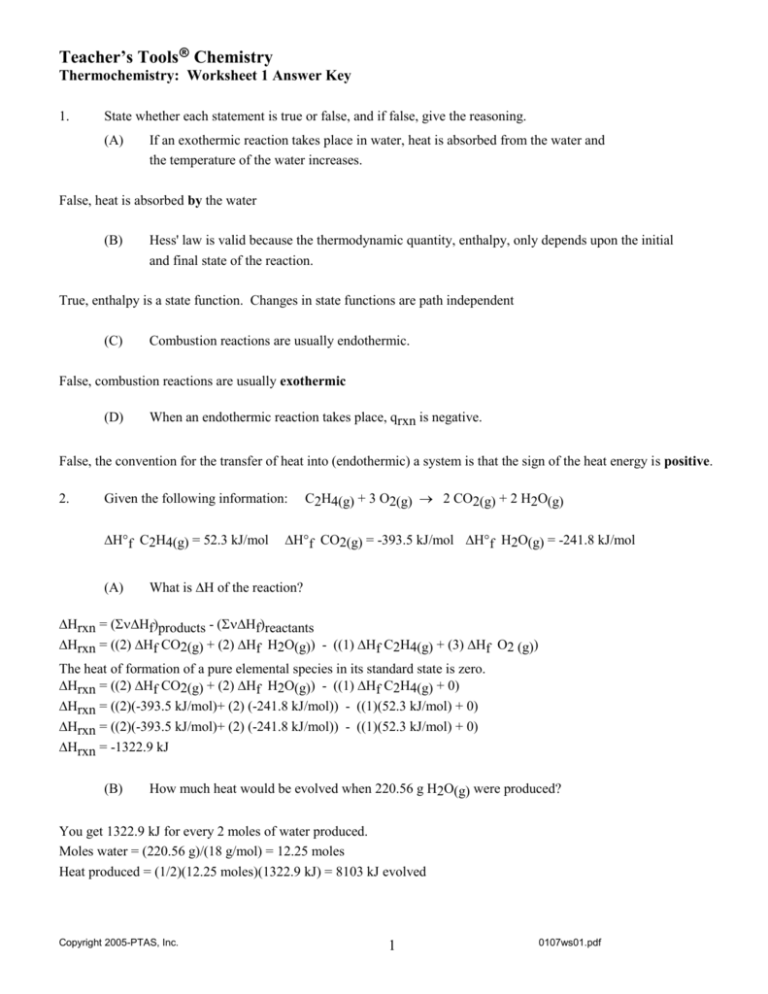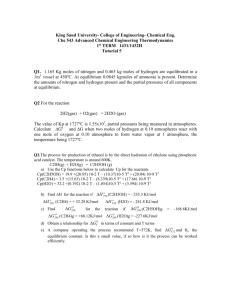type worksheet title here
advertisement

Teacher’s Tools® Chemistry Thermochemistry: Worksheet 1 Answer Key 1. State whether each statement is true or false, and if false, give the reasoning. (A) If an exothermic reaction takes place in water, heat is absorbed from the water and the temperature of the water increases. False, heat is absorbed by the water (B) Hess' law is valid because the thermodynamic quantity, enthalpy, only depends upon the initial and final state of the reaction. True, enthalpy is a state function. Changes in state functions are path independent (C) Combustion reactions are usually endothermic. False, combustion reactions are usually exothermic (D) When an endothermic reaction takes place, qrxn is negative. False, the convention for the transfer of heat into (endothermic) a system is that the sign of the heat energy is positive. 2. Given the following information: Hf C2H4(g) = 52.3 kJ/mol (A) C2H4(g) + 3 O2(g) 2 CO2(g) + 2 H2O(g) Hf CO2(g) = -393.5 kJ/mol Hf H2O(g) = -241.8 kJ/mol What is H of the reaction? Hrxn = (Hf)products - (Hf)reactants Hrxn = ((2) Hf CO2(g) + (2) Hf H2O(g)) - ((1) Hf C2H4(g) + (3) Hf O2 (g)) The heat of formation of a pure elemental species in its standard state is zero. Hrxn = ((2) Hf CO2(g) + (2) Hf H2O(g)) - ((1) Hf C2H4(g) + 0) Hrxn = ((2)(-393.5 kJ/mol)+ (2) (-241.8 kJ/mol)) - ((1)(52.3 kJ/mol) + 0) Hrxn = ((2)(-393.5 kJ/mol)+ (2) (-241.8 kJ/mol)) - ((1)(52.3 kJ/mol) + 0) Hrxn = -1322.9 kJ (B) How much heat would be evolved when 220.56 g H2O(g) were produced? You get 1322.9 kJ for every 2 moles of water produced. Moles water = (220.56 g)/(18 g/mol) = 12.25 moles Heat produced = (1/2)(12.25 moles)(1322.9 kJ) = 8103 kJ evolved Copyright 2005-PTAS, Inc. 1 0107ws01.pdf Teacher’s Tools® Chemistry Thermochemistry: Worksheet 1 Answer Key (C) How many moles of C2H4(g) would be required to produce 400.0 kJ of heat? You get 1322.9 kJ for every 1 mole of C2H4(g) produced. Moles C2H4(g)= (400.0 kJ)/( 1322.9 kJ/mole) = 0.302 moles 3. 4HCN(l) + 9O2(g) 4CO2(g) + 4NO2(g) + 2H2O(l) H = -2,445.8 kJ Hf NO2(g) = 33.85 kJ/mol Hf CO2(g) = -393.5 kJ/mol Hf H2O(l) = -285.8 kJ/mol Calculate Hf for HCN(l) Apply Hess’s Law and you get one equation with one unknown. ΔHo = νΔHof PRODUCTS νΔHof REACTANTS -2,445.8 kJ = ((4)(33.85 kJ) + (4)(-393.5 kJ) + (2)(-285.8 kJ)) – ((4)(x) + (9)(0)) solve for x and you get Hf for HCN(l) = 108.9 kJ/mol 4. Calculate Hf of propane, C3H8, given the following information: 2 C3H8(g) + 10 O2(g) 6 CO2(g) + 8 H2O(l) C(s) + O2(g) CO2(g) 2H2(g) + O2(g) 2H2O(l) H = -4439.4 kJ H = -393.5 kJ H = -571.6 kJ The first reaction is the combustion of propane. The second reaction is the formation reaction for carbon dioxide. The third reaction is twice the formation reaction for water. Apply Hess’s Law and you get one equation with one unknown. ΔHo = νΔHof PRODUCTS νΔHof REACTANTS -4439.4 kJ = ((6)(-393.5 kJ) + (8)(-285.8 kJ)) – ((2)(x) + (10)(0)) solve for x and you get Hf for C3H8(g) = -104.0 kJ/mol 5. When nitromethane, CH3NO2 (molecular mass = 61.05) is burned the following reaction occurs: 2CH3NO2(l) + O2(g) -----> 2CO2(g) + N2(g) + 3H2O(g) Given the following information: Hf CO2(g) = -393.5 kJ/mol Hf H2O(g) = -241.8 kJ/mol Hf CH3NO2(l) = 112.0 kJ/mol Copyright 2005-PTAS, Inc. 2 0107ws01.pdf Teacher’s Tools® Chemistry Thermochemistry: Worksheet 1 Answer Key (A) Calculate H for the burning of 1 mole of nitromethane. H for the burning of 1 mole of nitromethane = (1/2)Hrxn Hrxn = (Hf)products - (Hf)reactants Hrxn = ((2) CO2(g) + (1) Hf N2(g) + (3) Hf H2O(g)) - ((2) Hf CH3NO2(l) + (1) Hf O2(g)) The heat of formation of a pure elemental species in its standard state is zero. Hrxn = ((2) CO2(g) + 0 + (3) Hf H2O(g)) - ((2) Hf CH3NO2(l) + 0) Hrxn = ((2)(-393.5 kJ/mol) + 0 + (3)( -241.8 kJ/mol)) - ((2)( 112.0 kJ/mol) + 0) Hrxn = -1,736.4 kJ H for the burning of 1 mole of nitromethane = -868.2 kJ (B) What is H when 18.02 g H2O(g) is formed in the above reaction? You get 1,736.4 kJ for every 3 moles of H2O(g produced. Moles H2O(g) = (18.02 g)/( 18.02 g/mole) = 1 mole H = (-1,736.4 kJ)(1/3) = -578.7 kJ Copyright 2005-PTAS, Inc. 3 0107ws01.pdf








